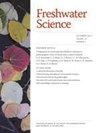湿地恢复的水质结果取决于水期而不是恢复策略
IF 1.6
4区 环境科学与生态学
Q3 ECOLOGY
引用次数: 0
摘要
土地管理者越来越多地利用湿地恢复来改善水质,特别是在耕地景观中。在农业湿地恢复中,管理者定期挖掘从周围景观中侵蚀的累积沉积物,以增加蓄水能力,减少入侵物种覆盖,或改善水质。然而,泥沙开挖的效果是否受到湿地水期的影响尚不清楚。此外,我们缺乏挖掘影响在恢复湿地中持续多久的数据。研究了美国明尼苏达州中西部草原坑区54个恢复后1 ~ 10年的农业湿地的溶解营养物浓度(即NH4+、NO3 -、总溶解N、可溶性活性P、总溶解P和溶解有机C)作为水质指标。在其中的26个湿地中,恢复从业者通过去除地下瓦排水和堵塞地表排水沟渠(照常处理)恢复了自然(即季节性或半永久性淹没)水文制度。在28个湿地中,从业者在恢复水文之前,将累积的沉积物移走,并将其重新沉积在周围的景观上(挖掘处理)。我们发现,在开挖处理组的湿地中,溶解P浓度最初降低,但随着时间的推移,P水平增加,特别是在水周期较短的湿地中。挖掘湿地的NH4+和溶解有机C浓度低于正常湿地,但这一趋势是由半永久性湿地不同修复措施的差异驱动的。氮和磷的动态几乎普遍与水周期有关,无论是在恢复后立即还是随后的年份。我们假设,水期的影响可能通过直接机制(与水期相关的水位波动)和间接机制(季节性湿地中密集涌现的大型植物群落的发展)与氧化还原条件的差异有关。在有季节性水期的流域,无机氮浓度随时间的推移而降低,无机磷浓度则随时间的推移而增加,表明净磷动员与氮限制同时增加。我们的研究结果表明,水期调节了湿地恢复后遗留P的表达,而沉积物去除对水质结果的长期影响很小。本文章由计算机程序翻译,如有差异,请以英文原文为准。
Water-quality outcomes of wetland restoration depend on hydroperiod rather than restoration strategy
Land managers increasingly use wetland restoration to improve water quality, particularly in cultivated landscapes. In agricultural wetland restoration, managers regularly excavate accumulated sediments eroded from the surrounding landscape to increase water storage capacity, decrease invasive species cover, or improve water quality. However, it is unclear whether the effects of sediment excavation are influenced by wetland hydroperiod. Additionally, we lack data on how long excavation effects persist in restored wetlands. We examined dissolved nutrient concentrations (i.e., NH4+, NO3–, total dissolved N, soluble reactive P, total dissolved P, and dissolved organic C) as proxies for water quality in 54 restored agricultural wetlands ranging from 1 to 10 y post-restoration in the Prairie Pothole Region of west central Minnesota, USA. In 26 of these wetlands, restoration practitioners restored natural (i.e., either seasonal or semipermanent inundation) hydrological regimes by removing subsurface tile drainage and plugging surface drainage ditches (business-as-usual treatment). In 28 wetlands, practitioners removed accumulated sediment and redeposited it on the surrounding landscape (excavated treatment) prior to restoring hydrology. We found that wetlands in the excavated treatment group initially experienced reduced dissolved P concentrations, but over time P levels increased, particularly in wetlands with shorter hydroperiods. Excavated wetlands had lower NH4+ and dissolved organic C concentrations compared with business-as-usual wetlands, but the trend was driven by differences between restoration treatments in semipermanent wetlands. N and P dynamics were almost universally related to hydroperiod, both immediately following restoration and over the ensuing years. We postulate that the effects of hydroperiod are likely related to differences in redox conditions via direct mechanisms (water level fluctuations related to hydroperiod) and indirect mechanisms (development of dense emergent macrophyte communities in seasonal wetlands). In basins with seasonal hydroperiod, inorganic N concentrations decreased over time and inorganic P concentrations increased, suggesting net P mobilization concurrent with growing N limitation. Our results illustrate that hydroperiod regulates the expression of legacy P following wetland restoration, with little long-term effect of sediment removal on water quality outcomes.
求助全文
通过发布文献求助,成功后即可免费获取论文全文。
去求助
来源期刊

Freshwater Science
ECOLOGY-MARINE & FRESHWATER BIOLOGY
CiteScore
4.10
自引率
0.00%
发文量
49
审稿时长
6-12 weeks
期刊介绍:
Freshwater Science (FWS) publishes articles that advance understanding and environmental stewardship of all types of inland aquatic ecosystems (lakes, rivers, streams, reservoirs, subterranean, and estuaries) and ecosystems at the interface between aquatic and terrestrial habitats (wetlands, riparian areas, and floodplains). The journal regularly features papers on a wide range of topics, including physical, chemical, and biological properties of lentic and lotic habitats; ecosystem processes; structure and dynamics of populations, communities, and ecosystems; ecology, systematics, and genetics of freshwater organisms, from bacteria to vertebrates; linkages between freshwater and other ecosystems and between freshwater ecology and other aquatic sciences; bioassessment, conservation, and restoration; environmental management; and new or novel methods for basic or applied research.
 求助内容:
求助内容: 应助结果提醒方式:
应助结果提醒方式:


